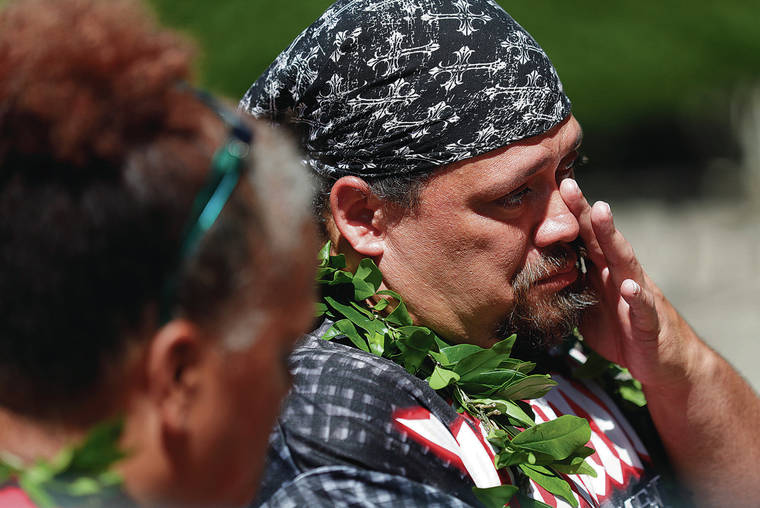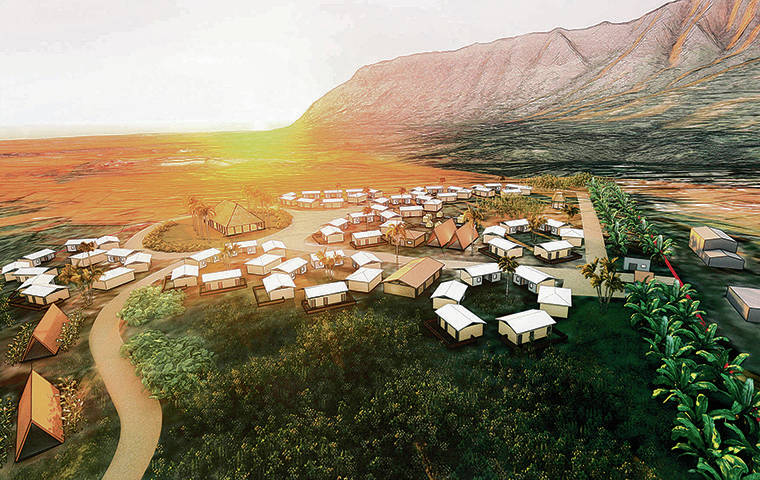Waianae homeless camp to move inland

JAMM AQUINO / JAQUINO@STARADVERTISER.COM
Pu‘uhonua o Waianae’s board president, James Pakele, became emotional during the announcement of the purchase of a 20-acre parcel of land.

RENDERING COURTESY PU‘UHONUA O WAIANAE
A rendering of Pu‘uhonua o Waianae was shown during Monday’s news conference. At top, the nonprofit group’s board president, James Pakele, became emotional during the announcement of the purchase of a 20-acre parcel of land.


In the first project of its kind, the leaders of the 219-person homeless encampment known as Pu‘uhonua o Waianae next to the Waianae Small Boat Harbor announced Monday that they are in escrow to buy a 20-acre parcel of private, undisclosed agricultural land mauka of Farrington Highway where they plan to create permanent housing out of tiny homes.
The group’s leader, Twinkle Alohalani Borge, and James Li‘ili‘i Pakele, board president of the nonprofit group Dynamic Community Solutions, told reporters outside the state Capitol that they’ve raised more than $800,000 through more than 200 private donations to buy the land.
They hope to raise an additional $650,000 by the end of February 2020 so there will be no mortgage on the property.
Major contributors include Alexander & Baldwin, Henry and Colene Wong Foundation, Island Insurance Foundation, Nareit Foundation, Pyramid Insurance Centre Ltd. and Group 70 International Inc.
A website — alohaliveshere.org — has been created to solicit donations for the new location for Pu‘uhonua o Waianae and for the next phase to build tiny homes on the property.
Borge called the announcement “a major milestone for our village.”
Don't miss out on what's happening!
Stay in touch with breaking news, as it happens, conveniently in your email inbox. It's FREE!
The land already includes water and electricity, Pakele said, and all 219 people currently living near the boat harbor — including 21 children — will be invited to move into the new version of what will still be called Pu‘uhonua o Waianae.
The residents likely will pay $200 to $250 per month to cover utilities and other amenities, such as trash pickup, Pakele said.
The new Pu’uhonua o Waianae location expects to accommodate no more than 250 residents. As residents move in and out, some of them could be newcomers who do not currently live in the encampment next to the Waianae Small Boat Harbor.
The announcement follows years of frustrations and complaints of excessive water use at the boat harbor, vandalism and trash blamed on some residents of Pu‘uhonua o Waianae.
The state Department of Land and Natural Resources also raised concerns of damage to a rare “Waianae lineage” of half-inch-long red shrimp called opae ula, which live below the 19.5-acre encampment — as well as fears of damage to ancient burial sites and pre- and post-contact rock walls.
Borge has said the people of Pu‘uhonua o Waianae offered to pay for their water use and asked to be taught how to properly care for the opae ula.
Pakele on Monday repeatedly teared up during the announcement of the land purchase.
Borge, 50, who has lived at Pu‘uhonua o Waianae since 2003, also called the upcoming move “real scary.”
“It’s the only real home I know,” she said of the current camp.
The new property is about a mile and a half from Farrington Highway, Pakele said.
The first residents are expected to relocate from next to the boat harbor sometime in 2020, but Borge said she will be the last to move out. Borge said she promised state officials there will be no remnants of the encampment once she leaves.
As Hawaii continues to grapple with the highest per capita rate of homelessness in the country, pressure grew on Gov. David Ige to sweep the encampment, a move that risked scattering a couple hundred homeless people across the Leeward Coast.
But a 2018 meeting between Borge and Ige at the Nanakuli home of legendary waterman Buffalo Keaulana deescalated the situation.
Borge has been mentored by Hawaiian sovereignty leader Dennis “Bumpy” Kanahele, who runs the nonprofit organization Aloha First.
Between 1993 and 1994 Kanahele led an occupation of Makapuu Beach Park that included 300 people, mostly Native Hawaiians.
As the occupation generated international attention and tensions rose, in 1994 Kanahele signed a 55-year lease on undeveloped, state-owned mauka lands for $3,000 per year, or $250 per month.
Kanahele named the site Pu‘uhonua o Waimanalo.
“Pu‘uohonua” means “refuge,” and Kanahele previously told the Honolulu Star-Advertiser that the names Pu‘uhonua o Waiamanalo and Pu‘uhonua o Waianae are no coincidence because of his mentorship of Borge on issues including Native Hawaiian rights.
While Kanahele leases state lands, the new version of Pu’uhonua o Waianae relies on private donations to buy property outright.
Now Borge is mentoring homeless leaders in Kakaako and Waimanalo about how to organize themselves, said Lt. Gov. Josh Green, who has made reducing homelessness one of his top priorities.
Asked about concerns from Waianae neighbors about Pu‘uhonua o Waianae’s upcoming move to mauka lands, Green said the concept of Not in My Backyard no longer exists when it comes to island homelessness.
“It’s already in our backyard,” Green said.
Green, a Hawaii island emergency room physician, pledged to organize health care outreach for the new Pu‘uhonua o Waianae.
By keeping the community together, Green said it will help reduce drug use, violence and other problems.
Monday’s announcement represents a positive development for a homeless situation that appeared to have no easy solution.
“Something had to happen,” Green said.




